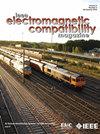基于BLT方程和场强关系的矩形空腔任意观测点屏蔽效能预测
IF 2.5
3区 计算机科学
Q3 ENGINEERING, ELECTRICAL & ELECTRONIC
IEEE Transactions on Electromagnetic Compatibility
Pub Date : 2025-03-30
DOI:10.1109/TEMC.2025.3571203
引用次数: 0
摘要
本文基于Baum-Liu-Tesche (BLT)方程和场强关系,提出了一种改进的矩形围护结构内任意观测点屏蔽效能预测模型。利用BLT方程对中心观测点的SE进行初步预测。从波导理论出发,推导了沿矩形外壳同一截面的两个观测点的SE之间的关系。随后,根据中心观测点的SE预测任意观测点的SE,对同一断面内的其他点进行预测。该模型通过考虑孔径位置因子以及高阶模态的特性阻抗和传播常数来考虑偏心孔径和高阶模态对SE的影响。此外,当系统在主模式下运行时,该模型允许使用模拟或实验数据获得已知观测点的SE值,从而可以直接预测同一断面内其他观测点的SE。这种方法最大限度地减少了重复模拟或实验的需要,节省了时间和成本。本文章由计算机程序翻译,如有差异,请以英文原文为准。
Prediction of Shielding Effectiveness at Arbitrary Observation Points in Rectangular Cavities Based on the BLT Equation and Field Strength Relationships
This article presents an improved model for predicting the shielding effectiveness (SE) at arbitrary observation points within a rectangular enclosure, based on the Baum–Liu–Tesche (BLT) equation and the field strength relationship. The SE at the central observation point is initially predicted using the BLT equation. The relationship between the SE at two observation points located along the same section of the rectangular enclosure is derived from waveguide theory. Subsequently, the SE at arbitrary observation points is predicted based on the SE at the central observation point, for other points within the same section. The model accounts for the impact of eccentric apertures and higher order modes on SE by incorporating the aperture position factor, as well as the characteristic impedance and propagation constant of higher order modes. Furthermore, when the system operates under the main mode, the model allows for the use of simulations or experimental data to obtain SE values for known observation points, thereby enabling the direct prediction of SE at other observation points within the same section. This approach minimizes the need for repeated simulations or experiments, saving both time and cost.
求助全文
通过发布文献求助,成功后即可免费获取论文全文。
去求助
来源期刊
CiteScore
4.80
自引率
19.00%
发文量
235
审稿时长
2.3 months
期刊介绍:
IEEE Transactions on Electromagnetic Compatibility publishes original and significant contributions related to all disciplines of electromagnetic compatibility (EMC) and relevant methods to predict, assess and prevent electromagnetic interference (EMI) and increase device/product immunity. The scope of the publication includes, but is not limited to Electromagnetic Environments; Interference Control; EMC and EMI Modeling; High Power Electromagnetics; EMC Standards, Methods of EMC Measurements; Computational Electromagnetics and Signal and Power Integrity, as applied or directly related to Electromagnetic Compatibility problems; Transmission Lines; Electrostatic Discharge and Lightning Effects; EMC in Wireless and Optical Technologies; EMC in Printed Circuit Board and System Design.

 求助内容:
求助内容: 应助结果提醒方式:
应助结果提醒方式:


